Free Perspective-Taking Activities for Every Classroom
Get free social skills materials every week
No-prep lessons on self-regulation, emotional recognition, conversation skills, and more.
Sign up herePerspective taking helps students recognize how someone else might think or feel, then use that insight to communicate, collaborate, and solve problems. This guide brings together classroom-tested perspective-taking activities you can use across grades and settings. You will find quick warm ups, printable visuals, structured scenarios, and full lesson plans that make the skill concrete for your students.
Use these activities for perspective-taking during whole-class instruction, small groups, or therapy sessions. Each item includes a short description, an image, and practical tips so you can teach the routine right away. Start with early learners who are naming feelings, move into elementary lessons that connect clues to thoughts, and finish with middle and high school resources that build social reasoning and flexible thinking.
What Is Perspective Taking
Perspective taking is the ability to understand how another person thinks or feels in a given situation. For the students you support, whether they are working on social communication goals, navigating peer relationships, or building stronger reading comprehension, this means more than guessing someone’s emotion. They learn to gather clues from facial expressions, tone of voice, and the context around an interaction, and then use those clues to imagine what another person might be thinking.
When you teach this skill explicitly, you help students move beyond “I know how I feel” to “I can imagine how you feel.” That shift is the foundation for empathy, problem solving, and healthy peer connections.
Why Teach Perspective Taking to Students
Perspective taking is not simply a social nicety. It is a core part of academic and social success. Students who can consider other points of view work more effectively in groups, resolve conflicts with less adult intervention, and communicate their own needs more clearly.
It also strengthens academics. Understanding a character’s motives in literature or predicting how a historical figure might react to an event both rely on the ability to step outside one’s own viewpoint. For many students receiving speech or special education services, these skills will not develop on their own. Your direct instruction gives them the language and structured practice they need to participate fully in classroom and community life.
Perspective Taking Activities for K–12 Students
Building strong perspective-taking skills helps students of every age understand others’ thoughts, feelings, and intentions. These skills form an essential foundation for empathy, communication, and positive relationships. Whether you teach preschoolers who are just beginning to notice others’ emotions or high schoolers navigating complex social dynamics, these ready-to-use lessons and printables give you practical ways to make perspective taking part of everyday learning.
The activities below include quick visuals and goal posters, interactive worksheets, and full lesson plans. Each one is designed to spark conversation, guide reflection, and help students practice stepping into someone else’s point of view no matter their grade level.
How Do You Feel? Lesson Plan
Grade Band: Pre-K & Kindergarten
This no-prep, illustrated lesson helps young children notice and name emotions by examining everyday situations and thinking about how different people might feel in them. It helps lay the foundation for perspective-taking by encouraging students to connect observable cues to internal feelings. The lesson quietly supports your wider work on perspective taking for early learners via this Understanding Feelings lesson.
Instructional Tips:
- Begin with a discussion: “How do we know when someone feels happy, sad, or surprised?” (Use facial expressions, body posture, voice.)
- Display one scenario card and ask: What do you see? How might that person feel? Why?
- Have students share their ideas, prompting them to point to the clues they noticed.
- Provide blank cards and invite students to draw their own emotional scenario; classmates guess the feeling and explain why.
- Throughout the day, prompt children to notice peers’ emotions and talk about what clues led them there (e.g. “I see Anna’s face looks sad—what do you see that tells you that?”).
Flexible Thinking Worksheet
Grade Band: Pre-K & Kindergarten
This simple worksheet invites young learners to practice thinking of multiple ways to respond to a situation—encouraging cognitive flexibility alongside early perspective-taking. It gently prompts children to consider “What else could I do?” in familiar scenarios, helping them start seeing that there are different responses (and viewpoints) in a situation. The concept ties into work on perspective taking for early learners.
Instructional Tips:
- Introduce the idea of “more than one way” by modeling two different responses to a simple situation (e.g. a toy conflict).
- Present the worksheet scenario and ask children: What could you do? What else could you do?
- Encourage them to draw or verbally share multiple responses—even silly ones.
- Celebrate all ideas, reinforcing that flexible thinking is about being creative, not one “right” answer.
- Revisit the worksheet later or apply the thinking prompt in real-time when students face everyday classroom challenges.
Showing Others We Care (Preschool Empathy Lesson)
Grade Band: Pre-K & Kindergarten
This no-prep activity uses simple illustrated scenarios to help very young learners notice others’ feelings and consider caring responses. It offers a gentle introduction to empathy and perspective-taking by making emotions visible and discussing how we can show kindness. The concept is quietly reinforced into your broader materials on perspective taking for early learners.
Instructional Tips:
- Start with a circle discussion: ask, “How do we know someone is sad or happy?” and talk about facial expressions, posture, and voices.
- Show one scenario from the activity and ask: What do you see happening? How might that person feel?
- Invite students to suggest caring responses: What could you do to help or show you care?
- Use role-play or puppet play to act out simple caring responses in the scenes.
- Throughout the day, prompt children to notice classmates’ emotions: “I see Alex looks upset. What could we do to show we care?”
Perspective Taking Goal Poster
Grade Band: Elementary
This printable poster gives students a clear, visual framework for understanding how others might think or feel in the same situation. It anchors abstract skills in everyday classroom practice and supports perspective taking for elementary students during discussions and conflict-resolution activities.
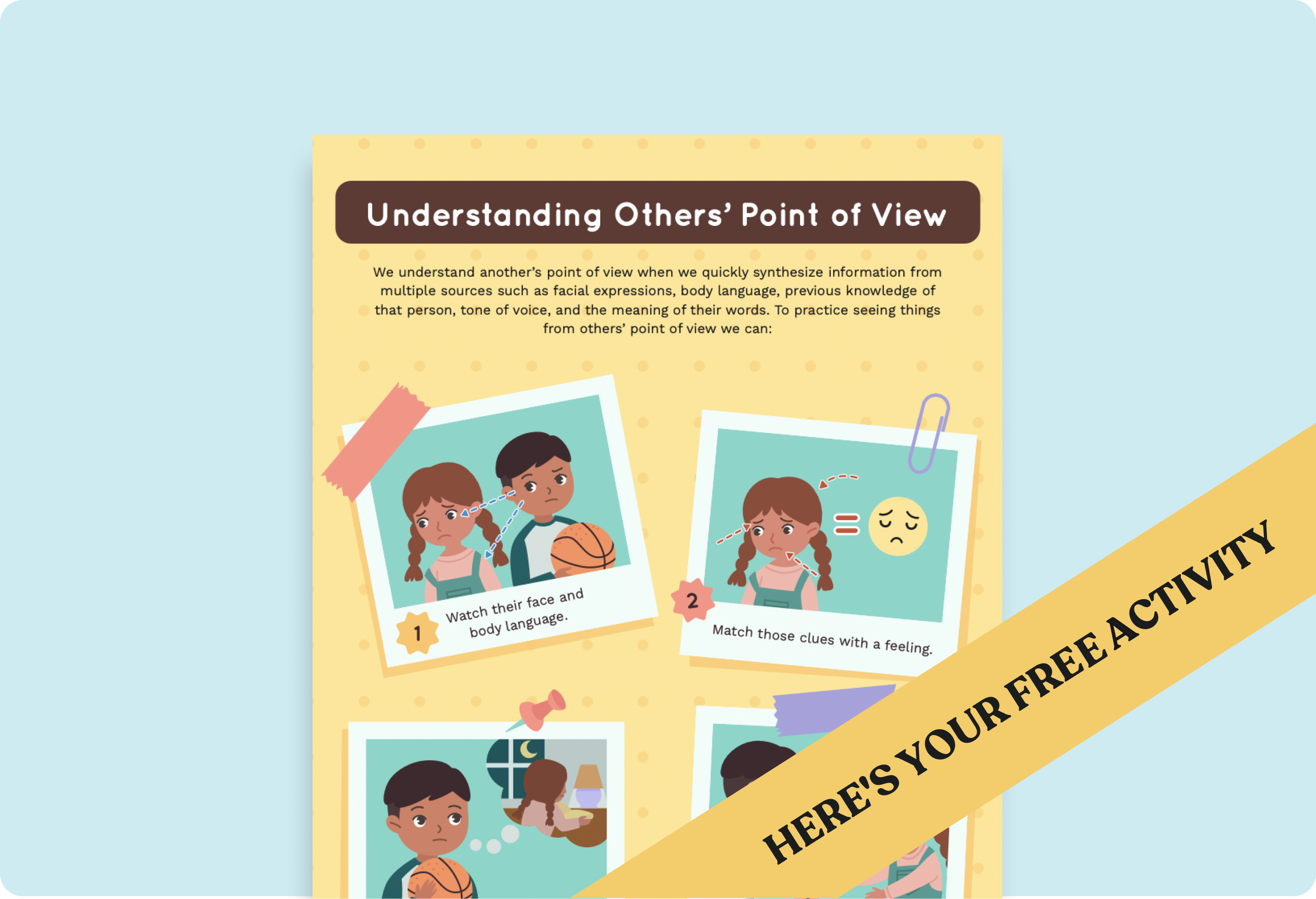
Instructional Tips:
- Start with a classroom discussion introducing what “point of view” means, using everyday situations (e.g. disagreements on the playground).
- Project or display the poster where all students can see it; review each statement and invite students to paraphrase in their own words.
- Use short scenarios (real or fictional) and model how one can “think through” with the poster: what clues signal how someone feels or believes.
- Encourage students to reference the poster during conflict resolution or discussions (“Let’s check our point-of-view poster”).
- Over time, invite students to generate their own perspective-taking statements or scenarios for the poster or class display.
How Do They Feel? Perspective-Taking Activity
Grade Band: Elementary
This visually engaging, no-prep activity invites students to examine illustrated scenes, read facial expressions and body language, and infer how different characters might feel. It helps build the habit of noticing social cues and considering others’ internal states while discussing our interpretations of each scenario. Use this alongside your broader work on perspective taking for elementary students.
Instructional Tips:
- Introduce the idea that people show feelings through facial expressions, posture, and context, then move into one illustrated scenario.
- Model thinking aloud: point out clues in the drawing, suggest possible feelings, and explain your reasoning.
- Let students work in pairs or small groups to examine additional scenes and share their ideas.
- Bring everyone back together for sharing, asking: “What clues did you notice? Why might someone feel differently than you predicted?”
- Over time, embed mini check-ins where students pause to notice how someone in class might be feeling and what clues led them to that thought.
Empathy Essentials Packet
Grade Band: Elementary
This packet offers a set of illustrated stories, discussion prompts, empathy maps, and extension ideas to help students explore how emotions, thoughts, and actions connect in real situations. It scaffolds perspective-taking in a structured but flexible way, giving students multiple entry points into “seeing through someone else’s eyes” via guided reflection and role play. The approach aligns well with perspective taking for elementary students through repeated exposure and practice.
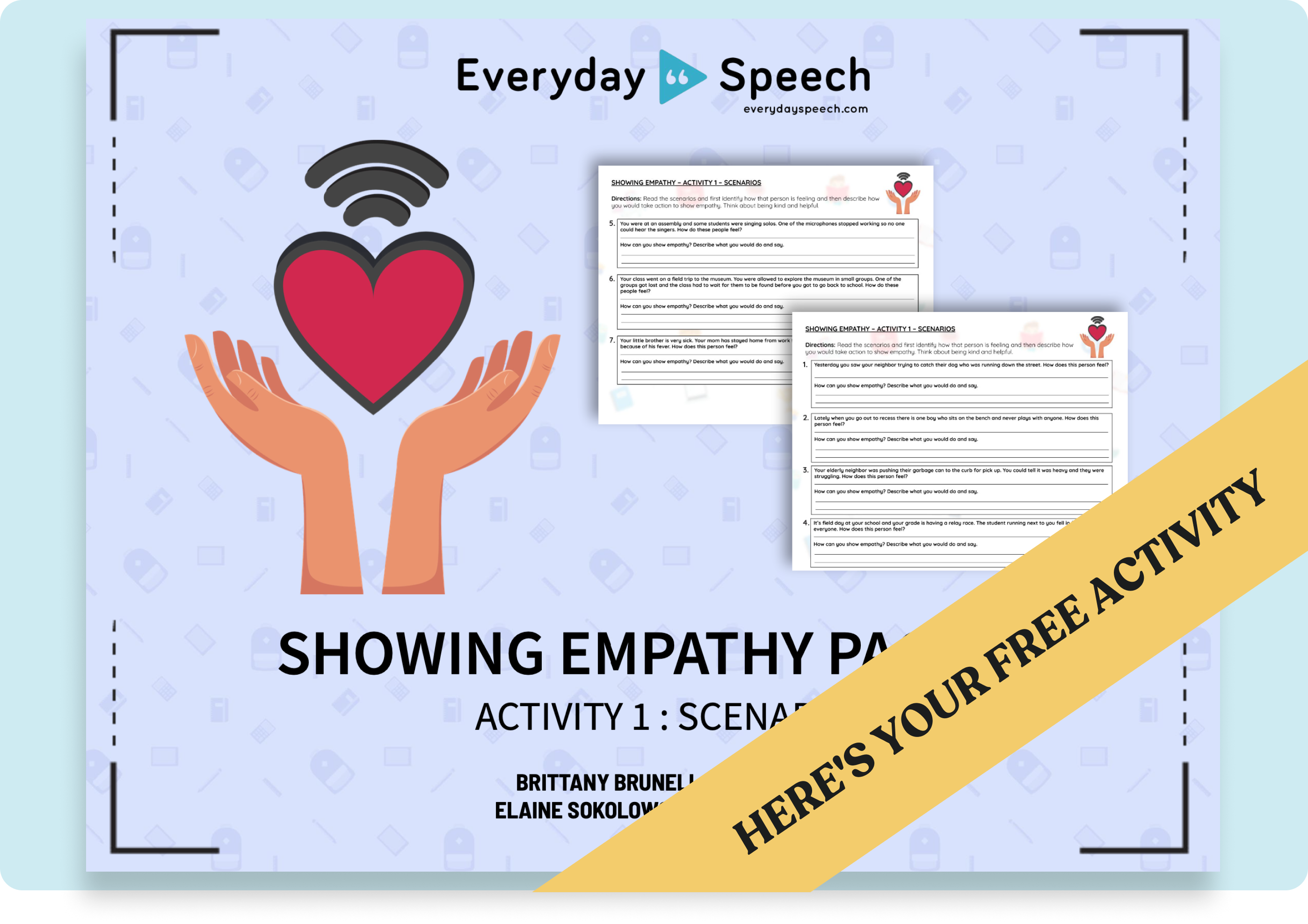
Instructional Tips:
- Begin by defining empathy and prompting students to share brief examples of noticing feelings in others.
- Read one scenario from the packet together, pausing to point out expressive clues (face, posture, context).
- Use the included empathy map worksheet: model filling it out (feelings, thoughts, actions) for one scenario.
- Have students work in pairs or small groups on additional scenarios and maps, then share and compare.
- Use short role-plays in class to animate scenarios, asking: “How might this character feel? What action shows empathy?”
- Revisit students’ own generated examples midweek, applying the empathy map steps to their real classroom interactions.
Using “I Feel” Statements
Grade Band: Elementary
This lesson helps students practice expressing their feelings and needs clearly by using “I feel [emotion] when [situation] because [reason]” statements. It supports perspective-taking by encouraging students to name their own internal experience and consider how others might hear it and folds into broader work on perspective taking for elementary students.
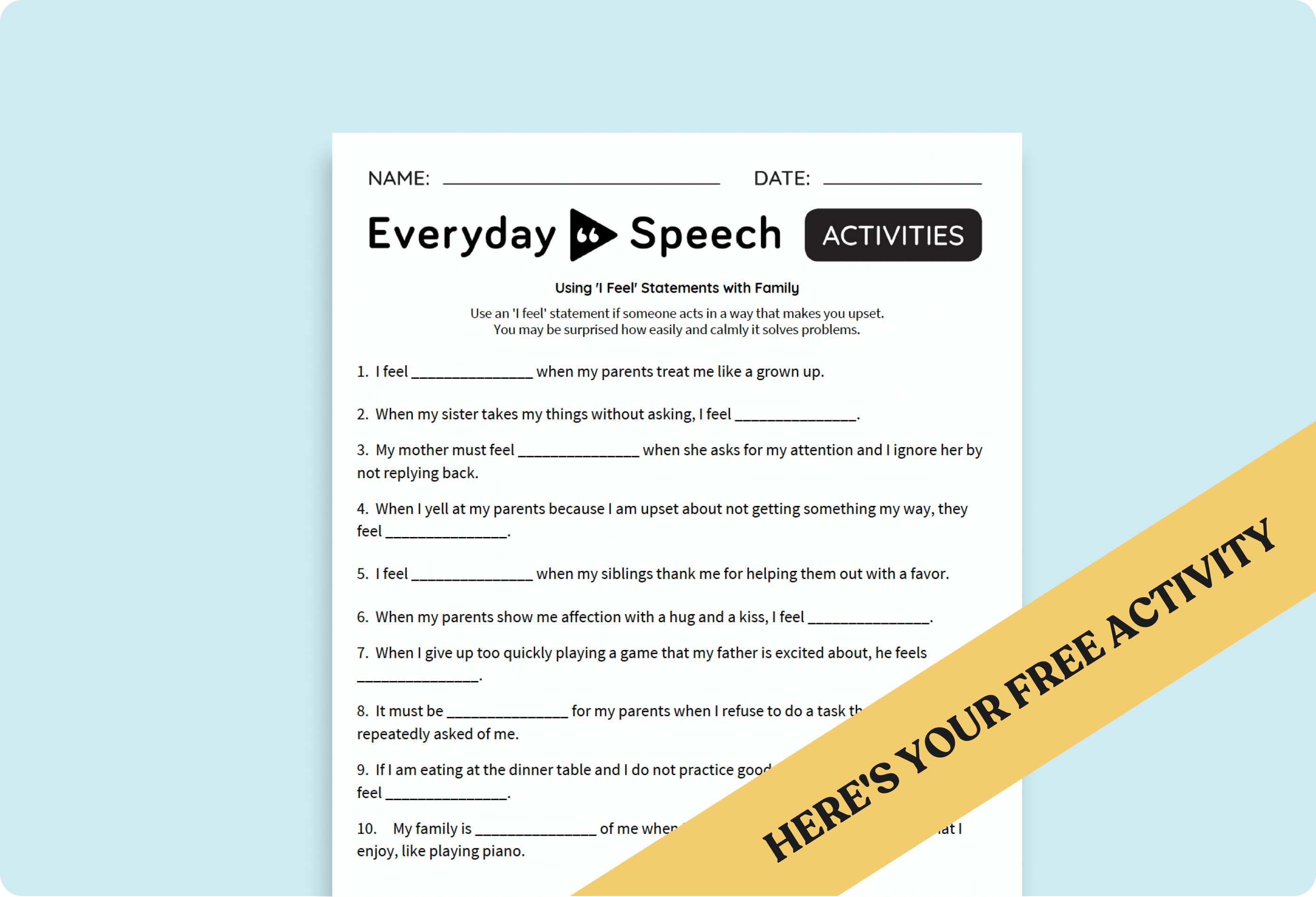
Instructional Tips:
- Introduce the structure: “I feel ___ when ___ because ___.” Model a few examples.
- Guide students through a few scenarios from the lesson, identifying possible emotions and reasons.
- Have students work in pairs or small groups to write their own “I feel” statements for given situations.
- Use role-play: let students express their statements and then switch roles to respond.
- Close with reflection: ask students to name a real situation where they might use an “I feel” statement and why.
Tuning In Goal Poster
Grade Band: Elementary
This no-prep visual lesson invites students to “tune in” by noticing what’s happening around them, interpreting social cues, and thinking about others’ possible feelings or responses. It helps scaffold perspective-taking by connecting observation to interpretation in everyday school contexts, and links into your ongoing work with perspective taking for elementary students.
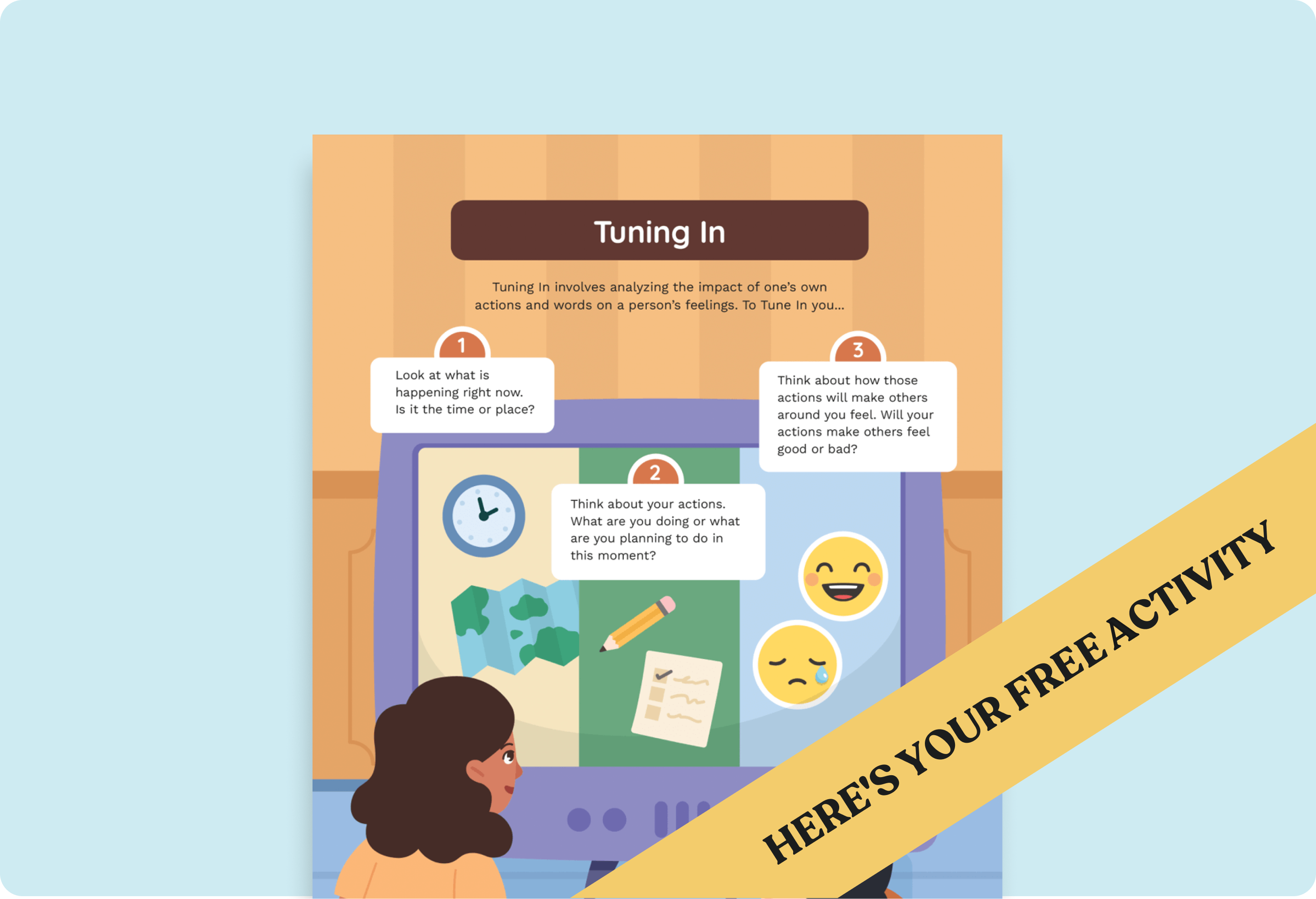
Instructional Tips:
- Begin by displaying the Tuning In poster and introducing or reviewing key vocabulary like tuning in, perspective, and others’ feelings.
- Model using simple scenarios: “I notice X is happening; I wonder how they might feel; maybe I could…”
- Lead the class in several short, guided practices using scenarios; prompt students with questions like “What clues do you see?” and “How might they feel?”
- Ask students to share real-life examples from school and tune in to what others might be thinking or feeling.
- Invite students to set a personal “tuning in” goal, such as noticing one extra cue or asking someone how they feel, and revisit it regularly.
Understanding the Perspective of Others
Grade Band: Middle School
This no-prep activity guides students through short scenarios to infer how different characters might think or feel in a situation. It strengthens their ability to pause, notice clues, and try on someone else’s viewpoint, reinforcing perspective taking for middle school students.
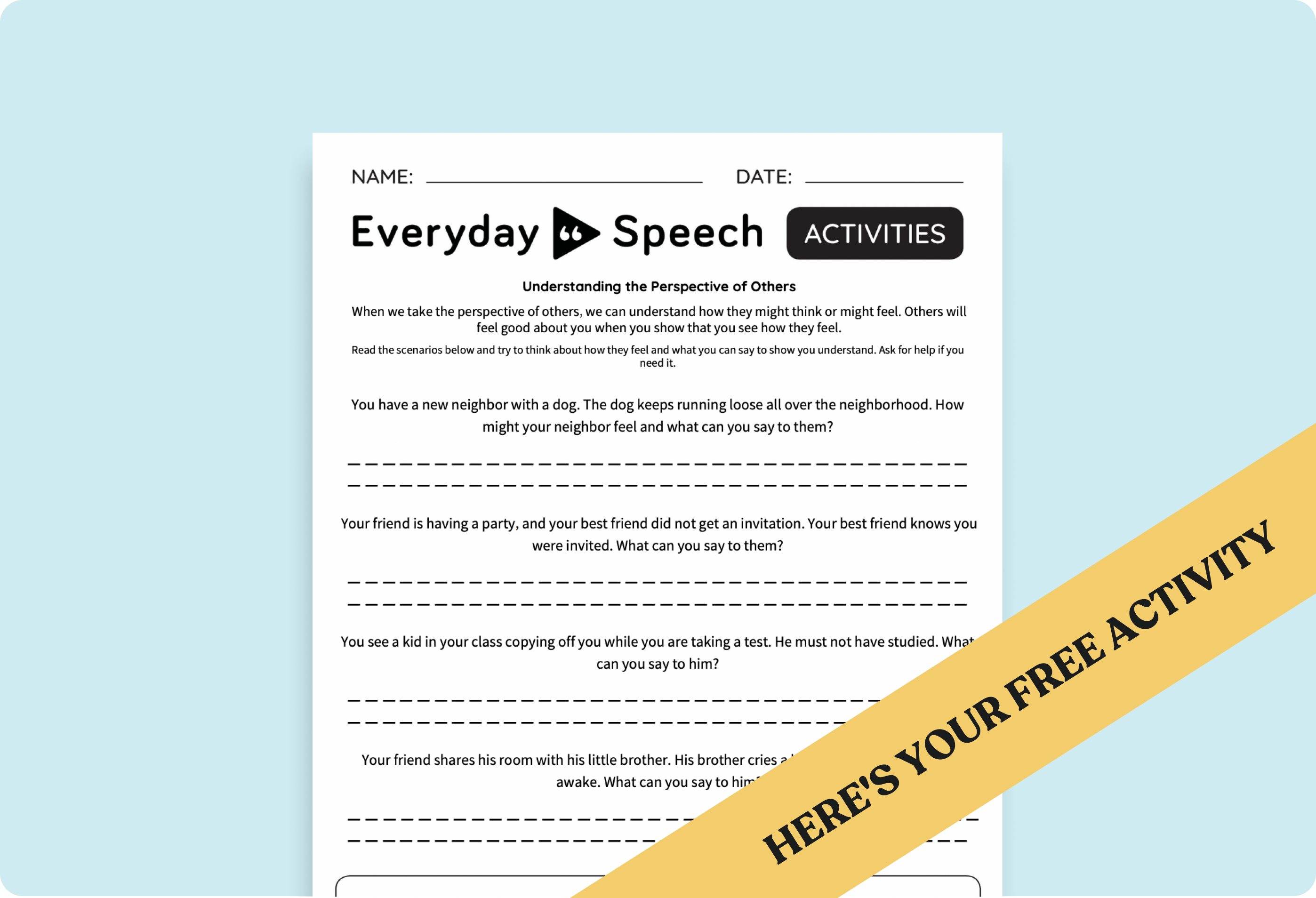
Instructional Tips:
- Open with a discussion: “Have you ever disagreed with someone because you saw things differently?”
- Model one scenario: read aloud, point out clues, and think aloud about possible thoughts/feelings.
- Let students work in pairs or small groups on additional scenarios, annotating clues and writing inferences.
- Hold a class debrief: have groups share different interpretations and justify their reasoning.
- Wrap up by asking students how this exercise could help in real peer interactions and encourage them to apply it in everyday settings.
Middle School Empathy Goal Poster
Grade Band: Middle School
This visual poster frames empathy in clear, actionable steps—helping students practice noticing others’ feelings, imagining perspectives, and choosing responses that are considerate. It becomes a touchstone during class conversations or conflict discussions and connects to perspective taking for middle school students.
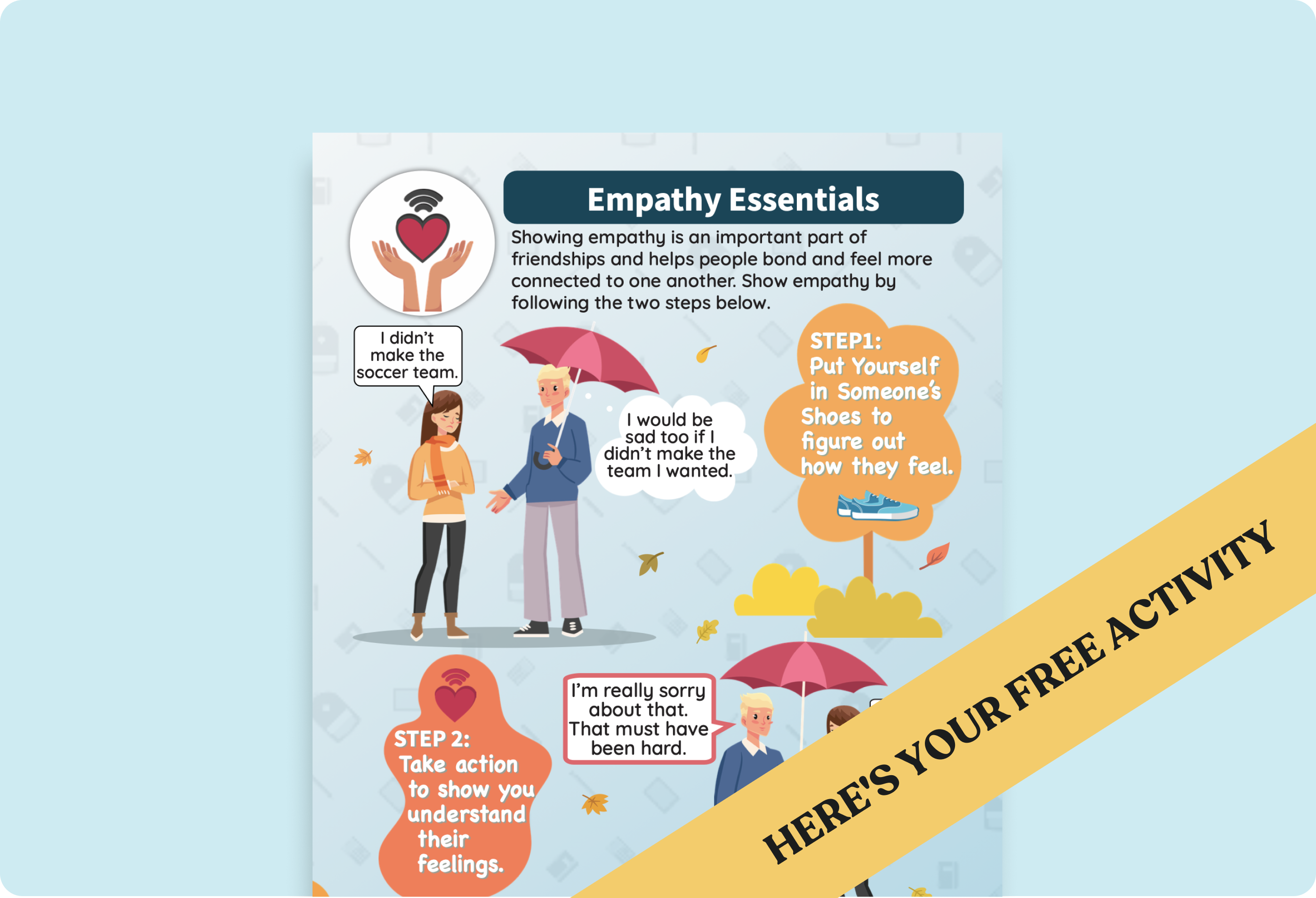
Instructional Tips:
- Introduce the poster by connecting it to real student experiences (e.g. misunderstandings, peer conflict).
- Walk through each step on the poster—pause for discussion and student paraphrase.
- Use sample or student-generated scenarios: ask, What might someone else be feeling here? What action would show empathy?
- Encourage students to refer back to the poster during group work or classroom disagreements.
- Later, invite students to co-create empathy steps or posters tailored to their class dynamics.
What Are They Thinking About? Interactive Tool
Grade Band: High School
This digital, no-prep activity presents scenarios where students infer what a character might be thinking based on contextual and visual cues. It strengthens social reasoning by connecting observable clues to possible thoughts and supports perspective taking for high school students in everyday interactions.
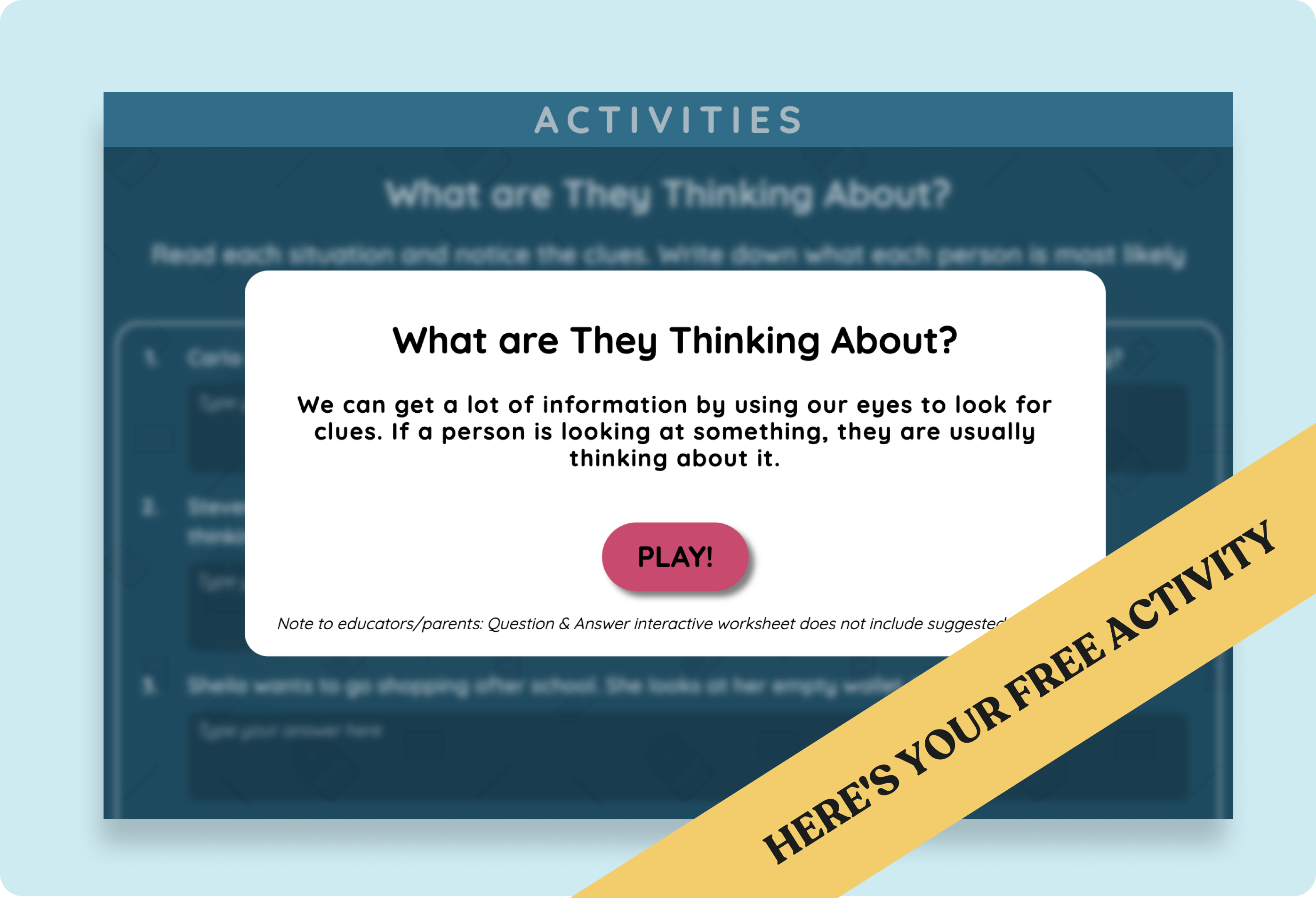
Instructional Tips:
- Begin by revisiting how clues (gaze, surroundings, prior events) inform what someone might be thinking.
- Model a scenario by asking aloud, “What do we see? What happened before? What might be going through their mind?”
- Have students work individually or in small groups through the interactive scenarios, annotating clues and writing inferences.
- Facilitate class discussion: share different interpretations and justify which clues weighed most.
- Encourage students to apply the reasoning in real life by noticing what peers might be thinking in everyday interactions.
Quick Activities for Perspective Taking
You do not need a full lesson block to keep this skill fresh. Here are a few routines you can drop into a morning meeting, therapy group, or classroom transition:
- Think–Pair–Share. Present a short scenario such as someone dropping a lunch tray or a classmate forgetting a homework assignment. Have students first think about how each person might feel, then discuss with a partner, and finally share with the group.
- Emotion Detective. Show a still image or photo and invite students to find the clues in eyes, posture, or setting that reveal what the person might be thinking or feeling.
- Point of View Swap. Describe a common conflict and ask students to explain their own reaction first, then switch and imagine the other person’s point of view.
- Two Reasons Game. Give a simple event such as a friend walking by without saying hello. Students list two different reasons why it might have happened, reinforcing the idea that there is rarely only one perspective.
These short practices build the habit of pausing and considering others’ thoughts even when time is tight.
Bringing Perspective Taking Into Every Classroom
Perspective taking is not a one-time lesson but a skill that grows through consistent practice. The activities on this page give you ready-to-use options for every grade level, from preschool through high school. Whether you are leading a speech–language session, supporting students in a resource room, or guiding a whole-class discussion, these ideas help students learn to look beyond their own viewpoint and understand others more fully.
Choose a few activities to start and weave them into daily routines—morning meetings, small-group work, or quick transition times. Over time you will see students become more aware of social cues, more considerate in their interactions, and more confident in expressing their own thoughts while respecting the perspectives of others.
Frequently Asked Questions
What are effective perspective-taking activities for younger students? Visual goal posters, simple illustrated scenarios, and guided “I feel” statements provide concrete supports that help children talk about what someone else might be thinking or feeling.
How can middle schoolers practice perspective taking? Use small-group discussions and structured role plays that require students to explain how they inferred another person’s thoughts or feelings and to back up their answers with clues.
Are there very quick activities I can use during homeroom or therapy warm-ups? Think–Pair–Share, Emotion Detective, and the Two Reasons Game can all be completed in just a few minutes while still giving students meaningful practice.
How is perspective taking different from empathy? Perspective taking is the cognitive skill of understanding another person’s viewpoint. Empathy adds the emotional layer of actually sharing or resonating with that feeling.Why is perspective taking critical for students with social communication goals? It supports pragmatic language, reduces peer conflicts, and helps students participate successfully in both academic tasks and everyday social interactions.
